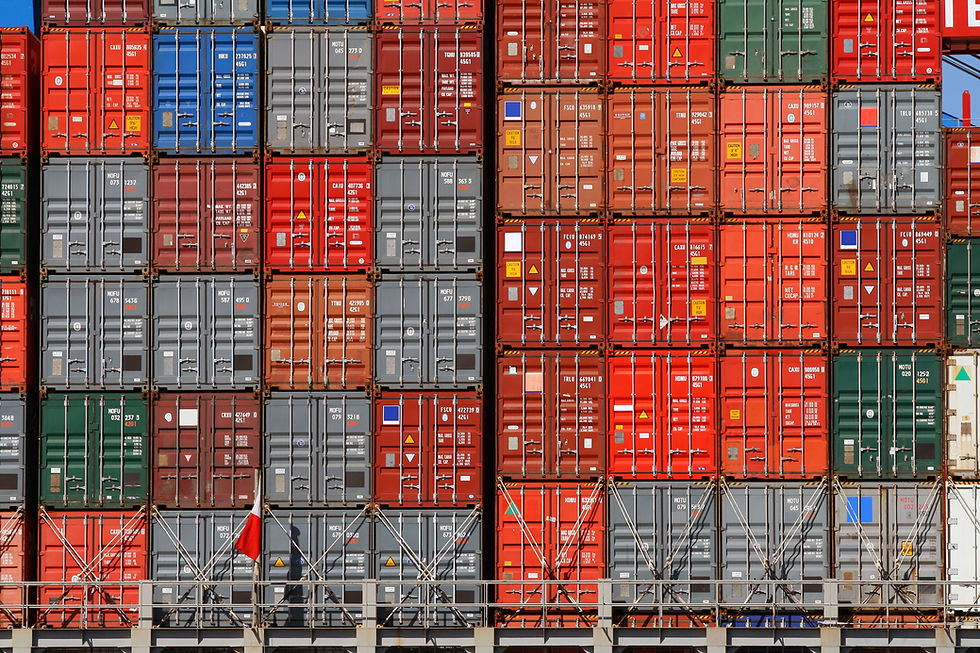7 Ways to Reduce Your Carbon Footprint Through Sustainable Logistics
- CNXtrans

- May 7, 2024
- 3 min read
In today's globalized world, efficient logistics are the backbone of international trade. However, traditional logistics practices often come at a high environmental cost, contributing significantly to greenhouse gas emissions. As businesses strive for sustainability, implementing eco-friendly practices within their supply chains has become increasingly crucial.
This article explores seven effective strategies businesses can adopt to reduce their carbon footprint through sustainable logistics:
1. Route Optimization and Consolidation:
Minimize Distance: Analyze delivery routes to identify the most efficient paths for your trucks, reducing unnecessary travel and fuel consumption. Utilize route planning software that considers factors like traffic congestion and distance.
Consolidate Shipments: Combine smaller shipments into fewer, larger ones whenever possible. This reduces the number of trips required and optimizes truck utilization. Explore multi-stop delivery routes and collaboration opportunities with other businesses to consolidate shipments traveling to similar destinations.
2. Utilize Sustainable Modes of Transport:
Shift to Rail and Water: Where feasible, explore alternative transportation options like railways and waterways for long-distance deliveries. While not always the fastest option, these modes generally boast lower carbon emissions compared to traditional road freight.
Invest in Electric Vehicles: Consider transitioning your delivery fleet to electric vehicles (EVs) or hybrid alternatives. As battery technology advances and charging infrastructure expands, EVs are becoming increasingly viable for short-haul deliveries within urban areas.
3. Implement Green Warehousing Practices:
Energy Efficiency: Upgrade your warehouse facilities with energy-efficient lighting systems, insulation, and climate control technologies. Utilize natural lighting whenever possible and explore renewable energy sources like solar panels to power your operations.
Warehouse Optimization: Optimize warehouse layouts to minimize travel distances for picking and packing operations. Implement efficient storage practices to maximize space utilization and reduce unnecessary product movement.
4. Sustainable Packaging Solutions:
Minimize Packaging: Design and implement packaging that uses minimal materials while still ensuring product protection. Explore biodegradable or recyclable packaging options to minimize waste and environmental impact.
Reduce Void Fill: Utilize void-fill materials made from recycled or sustainable content like air pillows or molded paper inserts. Eliminate unnecessary plastic packaging whenever possible.
5. Encourage Sustainable Supplier Practices:
Collaborate with Eco-Conscious Suppliers: Partner with suppliers committed to sustainable practices. Look for suppliers who utilize eco-friendly packaging, prioritize local sourcing, and implement renewable energy sources in their manufacturing processes.
Transparency and Communication: Communicate your sustainability goals to your suppliers and encourage them to adopt eco-friendly practices within their own operations. Collaboration fosters a more sustainable supply chain ecosystem.
6. Leverage Technology for Efficiency:
Telematics and Route Tracking: Implement telematics systems in your vehicles to track driver behavior, fuel efficiency, and optimize routes in real-time.
Warehouse Management Systems (WMS): Utilize warehouse management systems to optimize inventory management, picking and packing processes, and overall warehouse workflows, minimizing unnecessary energy consumption.
7. Invest in Sustainable Logistics Training:
Empowering Employees: Educate your employees about the importance of sustainable logistics and empower them to make eco-friendly choices in their daily operations. This can include training on fuel-efficient driving practices, waste reduction methods, and proper recycling procedures.
By implementing these strategies, businesses of all sizes can significantly reduce their carbon footprint within their logistics operations. Sustainable logistics not only benefit the environment but can also lead to cost savings through optimized transportation and reduced waste. As consumer awareness of sustainability grows, adopting eco-friendly practices can enhance brand reputation and attract environmentally conscious customers.
Remember, transitioning to sustainable logistics is an ongoing process. By continuously evaluating practices, seeking innovative solutions, and setting ambitious sustainability goals, businesses can play a vital role in building a more sustainable future for our planet.
Need a China-based Shipping Agent to help you consolidate and ship internationally from China?





Comments